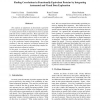Free Online Productivity Tools
i2Speak
i2Symbol
i2OCR
iTex2Img
iWeb2Print
iWeb2Shot
i2Type
iPdf2Split
iPdf2Merge
i2Bopomofo
i2Arabic
i2Style
i2Image
i2PDF
iLatex2Rtf
Sci2ools
BIBE
2006
IEEE
2006
IEEE
Finding Correlations in Functionally Equivalent Proteins by Integrating Automated and Visual Data Exploration
The analysis of alignments of functionally equivalent proteins can reveal regularities such as correlated positions or residue patterns which are important to ensure a specific fold and various cellular functions. Many approaches are found in the literature which try to identify correlated positions to predict the residues that are close to each other in the three-dimensional folded structure. However, the quality of the predictions remains disappointing. One of the problems is that the statistical correlation measures that were used cannot do justice to the underlying complex biological and physicochemical realities. In this paper we evaluate the biological requirements for a correlation measure and explain why a completely automatic approach is unlikely to succeed. We then propose a novel and flexible criteria for correlation of residue positions in protein sequences, which can be optimized for different requirements. To apply this definition we developed the tool VisAlign that c...
BIBE 2006 | Bioinformatics | Correlated Positions | Correlation Measure | Statistical Correlation Measures |
| Added | 10 Jun 2010 |
| Updated | 10 Jun 2010 |
| Type | Conference |
| Year | 2006 |
| Where | BIBE |
| Authors | Daniel A. Keim, Daniela Oelke, Royal Truman, Klaus Neuhaus |
Comments (0)

